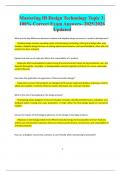Mastering IB Design Technology Topic 3:
100% Correct Exam Answers- 2025/2026
Updated
What are the key differences between iterative and adaptive design processes in product development?
Iterative design involves repeating cycles of prototyping and testing, refining the design after each
iteration. Adaptive design focuses on making adjustments based on real-world feedback, often after the
product has been released.
Explain how the use of materials affects the sustainability of a product.
Materials affect sustainability by determining the environmental impact during production, use, and
disposal. Renewable, recyclable, or biodegradable materials typically contribute to a more sustainable
product lifecycle.
How does the application of ergonomics influence product design?
Ergonomics ensures that products are designed to fit human needs and abilities, improving comfort,
safety, and usability. It directly influences factors like shape, size, and user interface.
What is the role of prototyping in the design process?
Prototyping allows designers to test and visualize concepts, identify potential issues, and gather user
feedback before moving into mass production. It helps refine the final design based on real-world
insights.
Discuss the impact of technological advances on the design of everyday products.
Advances in technology enable more efficient manufacturing, the incorporation of smart features,
and the use of innovative materials, which can enhance performance, convenience, and sustainability in
everyday products.
How can a designer ensure that a product is user-friendly while maintaining functionality?
1
, A designer can achieve this balance by focusing on usability testing, iterative design, and clear user
interfaces, ensuring that the product meets the user’s needs without compromising on its technical
capabilities.
Describe the concept of Design for Manufacture (DFM) and its importance.
DFM involves designing products in a way that simplifies the manufacturing process, reduces costs,
and minimizes errors. It ensures that a product is easy and cost-effective to produce while maintaining
quality.
What is the significance of material properties in product design?
Material properties like strength, flexibility, weight, and thermal conductivity are essential in choosing
the right material for specific functions and ensuring that the product performs well under intended
conditions.
How does sustainability influence design decisions in contemporary product development?
Sustainability influences design decisions by encouraging the use of eco-friendly materials, energy-
efficient manufacturing processes, and designs that prioritize longevity and recyclability, reducing the
overall environmental footprint.
Explain the importance of aesthetics in design and how it can affect product success.
Aesthetics play a crucial role in attracting customers and enhancing user experience. An
appealing design can influence emotional responses, create brand identity, and improve marketability,
leading to product success.
What is the role of empathy in user-centered design?
Empathy involves understanding the user's needs, challenges, and emotions. By incorporating
empathy, designers can create more relevant, accessible, and impactful products that improve the user's
experience and satisfaction.
How does the integration of technology in products create new challenges for designers?
The integration of technology introduces challenges such as ensuring compatibility with existing
systems, managing complexity, addressing privacy concerns, and maintaining ease of use while keeping
up with rapid technological changes.
2




